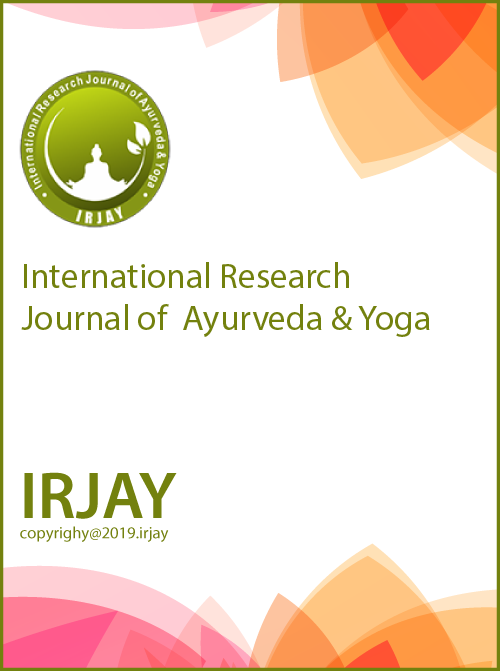Management of the Koshtha Shakhashrita Kamala: A Case Report
Keywords:
Ayurveda, Bilirubin, Case study, Hepatocellular Jaundice, Kamla, Kostha Shakha Ashrita Kamala, Mridu VirechanaAbstract
Jaundice is characterized by yellowing of the skin, sclera, and mucous membranes due to elevated bilirubin levels, often resulting from liver dysfunction. In Ayurveda, it is correlated with Kamala, a disorder caused by Pitta Dosha imbalance affecting the liver and peripheral tissues. This case study explores the potential of Ayurvedic approaches, including detoxification, herbo-mineral medicine, and dietary regulations in managing hepatocellular jaundice. A 50-year-old female patient presented with abdominal pain, fatigue, yellowish discoloration of the eyes and skin, and loss of appetite. Laboratory investigations revealed increased bilirubin levels, confirming jaundice. The patient was diagnosed with Koshta Shakhashrita Kamala based on clinical symptoms such as yellowish discoloration of the skin and eyes, abdominal pain, yellow stool, weakness, loss of appetite, as mentioned by Acharya Charak, and liver function test reports. Elevated bilirubin levels were found (total bilirubin – 4.22 mg/dL, direct – 0.72 mg/ dL, indirect – 3.50 mg/dL), indicating liver dysfunction rest all other parameters were normal. The Ayurvedic treatment plan included detoxification, herbo-mineral formulations, and lifestyle modifications. Mridu Virechana (mild purgative therapy) was administered to eliminate excess Pitta Dosha and restore liver function. The patient was prescribed Arogyavardhini Vati, Sharpunkha Churna, Giloy Churna, Bhumyamalaki Churna, Punarnava Mandoor, and Triphala Churna for their hepatoprotective and detoxifying properties. Dietary modifications and lifestyle adjustments were also recommended. The patient demonstrated marked clinical improvement, with total bilirubin levels decreasing from 4.22 mg/dL to 1.9 mg/dL. Similarly, direct bilirubin levels declined from 0.72 mg/dL to 0.13 mg/dL, and indirect bilirubin levels reduced from 3.50 mg/dL to 0.43 mg/dL. Symptoms, including fatigue and abdominal discomfort, were significantly alleviated, contributing to an improved quality of life. This case highlights the importance of early diagnosis and timely intervention in jaundice management. Integrating Ayurvedic detoxification methods, herbo-mineral formulations, and dietary modifications can effectively support liver function and promote recovery. Ayurveda offers a promising approach to managing jaundice and improving liver health.
Downloads
References
Ralston SH, Penman ID, editors. Davidson’s Principles and Practice of Medicine. 22nd ed. Netherlands: Elsevier; 2018. p. 860.
Golwalla AF, Golwalla S, Nadkar MY, editors. Golwalla’s Medicine for Students. 25th ed., Ch. 2. New Delhi: Jaypee Brothers Medical Publisher; 2018. p. 70.
Samhita C, Sthan C. Pandu Roga Chikitsa 16/40. Available from: https://niimh.nic.in/ebooks/echarak [Last accessed on 2025 Apr 07].
Hridya A, Sthan C. Panduroga Chikitsa 16/40. Available from: https://vedotpatti.in/samhita/vag/ehrudayam [Last accessed on 2025 Apr 07].
Samhita C, Sthan C. Panduroga Chikitsa 16/35. Available from: https://niimh.nic.in/ebooks/echarak [Last accessed on 2025 Apr 07].
Sharma PV, editor. Chakradutta, Chikitsa Sangraha. Ver. 23., Ch. 8. Varanasi: Chaukhamba Publication; 2013. p. 108.
Shastri A, editor. Rasratnasamuchchaya. Ver. 91-92., Ch. 20. Varanasi: Chaukhamba Publication; 2014.
Sharma P, Sharma G, editors. Kaideva Nighantu, Aushadhi Varga. Ver. 250. Varanasi: Chaukhamba Orientalia Publisher; 2009. p. 49.
Sharma P, Sharma G, editors. Kaideva Nighantu, Aushadhi Varga. Ver. 10. Varanasi: Chaukhamba Orientalia Publisher; 2009. p. 5.
Sharma P, Sharma G, editors. Kaideva Nighantu, Aushadhi Varga. Ver. 754. Varanasi: Chaukhamba Orientalia Publisher; 2009. p. 139.
Sharma P, Sharma G, editors. Kaideva Nighantu, Aushadhi Varga. Ver. 246. Varanasi: Chaukhamba Orientalia Publisher; 2009. p. 49.
Samhita C, Sthan C. Panduroga Chikitsa 16/128. Available from: https://niimh.nic.in/ebooks/echarak [Last accessed on 2025 Apr 07].
Shastri A, Samhita S. Uttar Tantra, Panduroga Pratished 44/38. Available from: https://niimh.nic.in/ebooks/esushrut [Last accessed on 2025 Apr 07].


